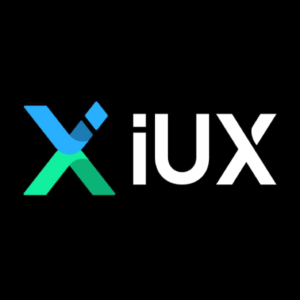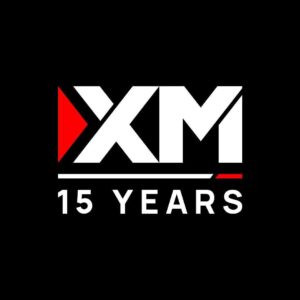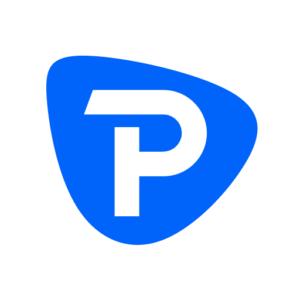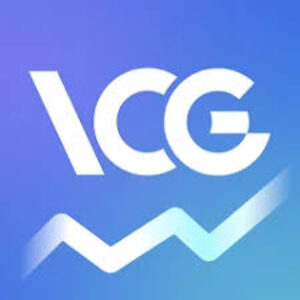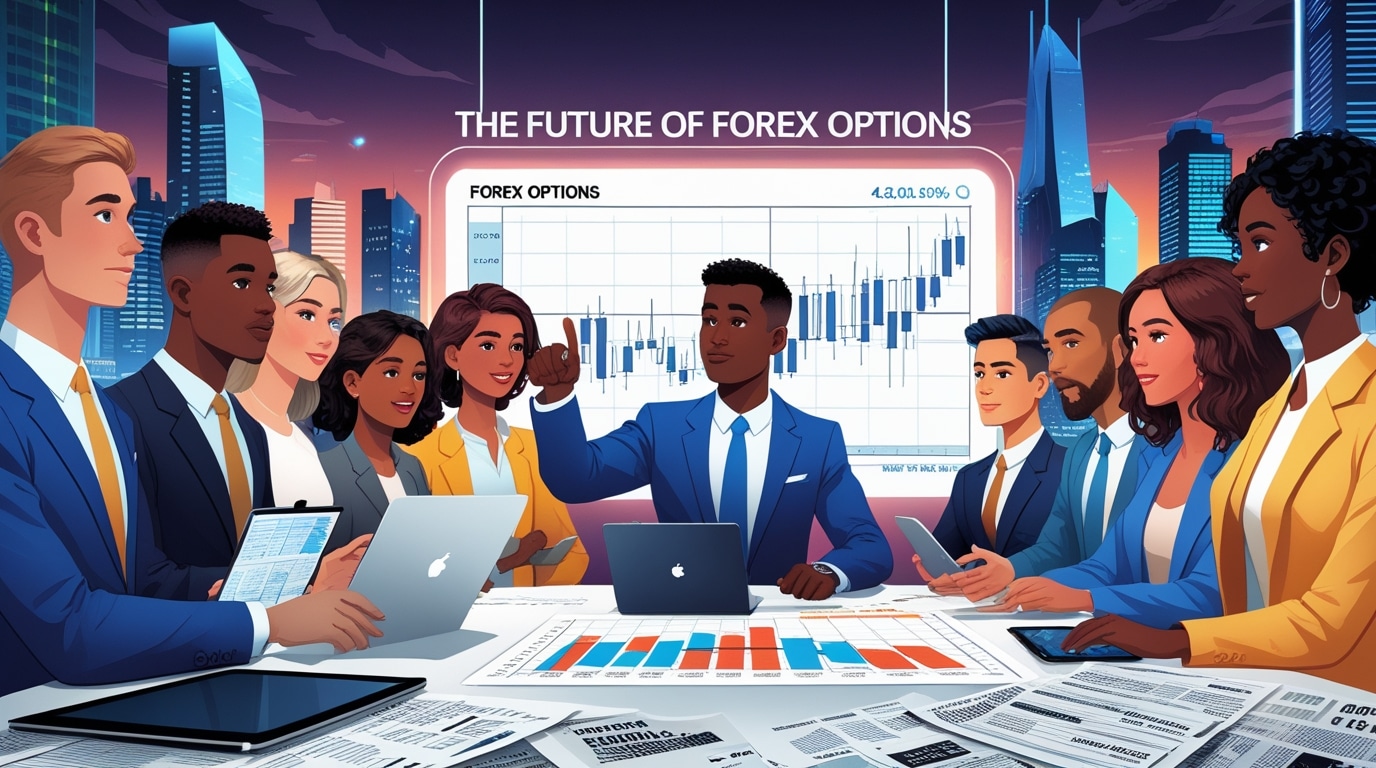
Forex (currency) options – derivative contracts giving the holder the right (but not obligation) to buy or sell a currency pair at a predetermined rate on or before a specific date – have become an important tool for investors and businesses. These instruments, often used for hedging or speculative purposes, now encompass a vast market (roughly $300 billion per day in notional volume). In recent years, the foreign exchange options market has evolved dramatically under the influence of technology, shifting liquidity, and global economic uncertainty. In this article, we examine the key trends shaping the future of forex options, the technological innovations powering their trading, and the market outlook ahead.
Overview: Forex Options
| Category | Key Insights & Market Trends |
|---|---|
| Market Size & Growth | Daily trading volume of $300 billion in notional volume. 88% of UK fund managers used currency hedging in 2024 (highest in a decade). Stablecoin market cap exceeds $200 billion, driving digital integration. |
| Technology Disruption | AI-driven automation Machine learning pricing Cloud-based platforms Mobile trading apps API integration Real-time analytics Advanced algorithms replacing manual trading methods across all major platforms. |
| Platform Evolution | Shift from OTC voice trading to centralized electronic venues. New multilateral trading facilities (MTFs) like OptAxe improving price discovery. Regulated exchanges (CME, ICE) offering standardized products. 24×5 trading becoming standard. |
| Trading Strategies | Hedging Directional speculation Volatility plays Income/carry strategies Binary/SPOT options Risk reversals showing bearish USD outlook with multi-year highs in EUR/USD positioning. |
| Major Brokers & Venues |
Institutional: CME Group ICE OptAxe MTF
Retail: IG Saxo Bank AvaTrade Plus500 City Index Binary: Nadex (regulated in US) |
| Regulatory Impact | Uncleared margin rules (UMR) increasing bilateral trading costs, driving migration to cleared platforms. Enhanced transparency requirements and investor protection measures. Compliance features embedded in trading systems. |
| Digital Assets Integration | Cryptocurrency and stablecoin integration into FX platforms. Blockchain technology for cross-border settlement. Crypto/fiat pair options becoming available. Tokenized collateral models under development. |
| Market Outlook 2025-2026 | Continued high volatility from divergent monetary policies and geopolitical tensions. Bearish USD consensus driving option positioning. Increased retail participation through gamified platforms. Further AI adoption for signal generation. |
Emerging Trends in the Forex Options Market
The landscape of FX options trading is being reshaped by several converging trends:
- AI and Automated Trading: Advanced algorithms and machine learning are transforming how currency options are priced and traded. Leading analytics firms note that “AI-driven automation, enhanced data analytics, and seamless integration across trading workflows are transforming how firms operate” in FX trading. Industry experts agree that automation is moving from niche to essential. As Goldman Sachs’ Ralf Donner observes, “Only a machine can [trade across many platforms] – a human trader can’t have 10 keyboards in front of him… it’s not possible”. In practice, more brokers now offer adaptive, AI-enhanced algorithms that continuously learn and adjust strategies as market conditions shift. This evolution helps traders manage complex portfolios and fragmented liquidity more efficiently than traditional manual methods.
- Electronic and Centralized Venues: Historically, FX options were traded over-the-counter (OTC) via voice or bilateral networks. A new generation of platforms is changing that. For example, OptAxe recently launched a regulated multilateral trading facility to digitize and centralize the distribution of FX options axes (market-making quotes). Such venues aim to improve price discovery and liquidity by aggregating quotations across participants. As OptAxe’s CEO Chris Jackson explains, their goal is to “bring much-needed innovation to the FX options market” by consolidating available liquidity into a single platform. Centralized execution and automated RFQ (request-for-quote) systems are expected to boost trading efficiency and reveal the true market price of options. In addition, regulated exchanges like CME Group offer listed currency options and even binary-style (called “SPOT”) FX products, giving traders standardized, transparent venues for certain FX derivatives.
- Data and Connectivity: Access to rich data is increasingly a competitive edge. Survey data show that firms are leveraging expanded datasets and analytics to improve pricing and execution. For example, pre-trade analytics (via transaction cost analysis or volatility forecasting) help traders choose optimal execution strategies, while real-time analytics can adjust trades on the fly. Platforms now provide extensive market data (including intra-day FX swaps, forward curves, etc.) and seamless connectivity (APIs, FIX, WebSocket) so that trading algorithms can operate 24/5 with minimal latency. The trend toward fully integrated trading environments – where orders, risk checks, and post-trade processing happen in one system – is gaining momentum to reduce manual errors and speed up workflows.
- Digital Currencies and Blockchain: Blockchain and digital assets are entering the forex arena. In 2025, many forex platforms began integrating cryptocurrencies and stablecoins into their product suites. Stablecoins (crypto tokens pegged to fiat) now have a market capitalization exceeding $200 billion, and forward-looking brokers are offering crypto payment or trading solutions alongside traditional FX. This integration allows traders to fund accounts in digital currencies or trade crypto/fiat pairs using option-like structures. Meanwhile, blockchain technology itself is being explored to streamline cross-border settlement and reduce counterparty risk in OTC FX.
- Regulatory and Structural Shifts: Post-2008 regulations continue to shape FX options trading. New uncleared margin rules (UMR) have significantly increased the cost of bilateral currency options, encouraging participants to trade on cleared or multilateral platforms. Regulators are also emphasizing transparency and investor protection. In response, technology providers embed compliance features (KYC/AML checks, automated reporting) directly into trading systems. Likewise, the growing trend of 24×5 FX trading (including weekend USD/EUR/JPY sessions on some platforms) reflects both client demand and regulatory approval for extended hours. Overall, participants must adapt to a regulatory landscape that values efficiency and risk controls in equal measure.
- Increased Volatility and Hedging Demand: Finally, geopolitical and economic volatility (from changing interest rates, trade policies, or global crises) is boosting demand for currency options. A recent survey reported that 88% of UK fund managers hedged currency exposure in 2024 – the highest in a decade – largely by buying options. With many major currencies experiencing swings, traders and corporations use options as insurance. Currency option prices (implied volatilities and risk reversals) have signaled heightened uncertainty: for example, investors are now taking “unprecedented” positions to own USD put options amid a projected dollar decline. In short, when volatility is expected to rise, options usage typically surges, since they allow precise bets on future moves with limited initial risk.
These trends collectively suggest that the future of FX options will be shaped by smarter technology and greater market reach. Traders can expect more automated, data-driven tools; more transparent, centralized platforms; and expanded product offerings (including structured and hybrid options). At the same time, the core use cases – hedging risk, speculating on currency moves, and optimizing carry – remain central, ensuring that forex options stay relevant to a broad range of market participants.
Technology Innovations in Forex Options Trading
Technology is a driving force behind many of the above trends. Next-generation platforms and tools are enabling traders to capitalize on FX options faster and with more insight:
- AI-Enhanced Pricing and Execution: Advanced computing techniques, including machine learning, are increasingly applied to option pricing and risk management. By analyzing vast amounts of market data, AI models can uncover patterns and correlations that traditional models miss. In practice, firms use AI to fine-tune volatility forecasts and to automate complex order strategies. For example, some trading systems blend quantitative analysis with macro models to forecast market responses, or use AI to determine optimal order timing. As market commentator David Kalita (Quantitative Brokers) noted at a recent industry conference, algorithmic tools allow traders to “scale and do things much faster and across a lot more markets”. This means that even institutions traditionally reliant on voice trading are adopting algorithmic strategies to handle high-frequency market data and fragmented venues.
- Big Data and Analytics: We are seeing a clear shift toward data-driven decision-making in FX options. Rather than relying solely on trader intuition, teams now employ real-time and historical analytics. For instance, pre-trade analytics can suggest which option strikes and maturities offer the best value given current implied volatilities. Post-trade analysis (via tools like transaction cost analysis) helps firms learn which execution algorithms perform best under specific conditions. The result is a “smarter” trading cycle: better pricing inputs lead to better models, which lead to more optimal trade execution. Such data-centric approaches also support regulatory obligations, by making it easier to document how trades were executed and to ensure compliance with market conduct rules.
- Cloud, Mobile and API Access: Technology providers are moving away from siloed systems and toward cloud-based, fully accessible platforms. Traders can now tap into FX options markets from a smartphone or tablet, reviewing positions and executing trades on the go. Mobile apps increasingly support advanced features such as interactive option charts, real-time alerts on currency shifts, and even embedded AI-driven trade ideas. Meanwhile, institutional clients benefit from versatile APIs (FIX, REST, etc.) that connect custom order management systems to liquidity pools and clearing venues. For example, OptAxe’s platform offers both a web GUI and connectivity via FIX/REST so that firms can integrate it into existing trading infrastructure. This kind of flexibility is crucial for firms seeking to automate complex workflows without human intervention.
- Advanced Platform Architecture: Exchanges and platforms are architecting for resiliency and scale. In 2025 Cboe noted that its new trading engine (Cboe Titanium) was built to process extremely high volumes and to stay resilient amid volatilitycboe.com. Though this example is from equity options, similar engineering applies to FX exchanges. Robust matching engines, low-latency data distribution, and redundant networks ensure that even during record trading days, the market remains orderly. In the FX context, this means that when a major news event hits, option chains across dozens of currency pairs can be priced and traded continuously without lags. Such technological backbone is essential: as FX options trading volumes grow, any downtime or latency can lead to large losses or mispricings.
- Innovation in UI/UX and Education: Finally, technology is making forex options more approachable, especially for newer traders. Interactive platform interfaces now include intuitive tools for building multi-leg strategies (spreads, straddles, risk reversals, etc.) with one click. Paper trading modes and detailed option chain visualizations help demystify complex instruments. Some brokers also incorporate social features, where traders can view or copy strategies from more experienced peers (though this is more common in spot/CFD trading, the idea is spreading). Educational resources (webinars, tutorials, AI-based assistants) are also proliferating, reflecting a drive to onboard retail users. All these factors point to a future where the technical barrier to entry is lower, while advanced professionals gain from cutting-edge analytics.
Forex Options Brokers and Platforms
As technology evolves, so do the venues and brokers offering FX options. Today, both institutional venues and retail brokers provide access to currency options:
- Institutional Venues: Major exchanges like the CME Group and Intercontinental Exchange (ICE) offer listed options on currency futures (e.g. EUR/USD, JPY/USD) and also OTC-style products with centralized clearing. These exchange-traded options are standardized and fully regulated, attracting banks, hedge funds, and asset managers who require transparency. New multilateral trading facilities (MTFs) like OptAxe (UK-based, FCA-authorized) are specifically designed to centralize OTC FX option liquidity and axe (pricing) distribution. These venues let participants request prices from many dealers simultaneously, improving visibility and execution quality. Over time, we may see similar MTFs or electronic communications networks (ECNs) emerge in other regions as regulators encourage consolidated trading.
- Retail FX and CFD Brokers: Several online brokers now allow individual traders to speculate on currency options. For example, IG and Saxo Bank (established FX brokers) enable clients to trade OTC currency options or CFDs on currency options. AvaTrade offers a dedicated options trading app (“AvaOptions”) covering dozens of forex pairs, including exotic crosses. Plus500 and City Index provide simpler web-based platforms where clients can trade options via CFDs on forex pairs. It’s important to note that retail forex options are often structured as contracts for difference (CFDs), meaning the trader never takes delivery of actual currency, but rather makes a wager on the option’s value. Traders should carefully compare brokers’ offerings – look at the range of available currencies, expiry dates, platform features, and regulatory oversight. In general, top-tier forex options brokers are those regulated by major authorities (e.g. FCA, ASIC, CFTC) and that offer transparent pricing and strong risk controls.
- Binary/Structured Options Providers: A subset of forex options involves simpler “binary” or digital contracts (also called SPOT contracts). These have fixed payoffs depending on whether a currency pair meets a specific condition by expiry. In the U.S., for example, the Nadex exchange offers regulated binary FX options under CFTC oversight. The Chicago Mercantile Exchange (CME) also lists digital FX products. However, many binary options are offered by offshore brokers. Regulators worldwide (like the CFTC and FINRA in the U.S.) strongly warn traders to avoid unregulated binary platforms, as they have been rife with fraud. In summary, while regulated venues do offer forex binary options, traders must ensure they use reputable, licensed brokers or exchanges for any FX options trading.
Forex Options Trading Strategies
Traders use forex options in various strategic ways, depending on their objectives:
- Hedging Currency Risk: A primary use of FX options is to protect against adverse currency moves. For example, an exporter expecting a foreign currency payment might buy a put option to lock in a minimum exchange rate. Similarly, asset managers often use currency options to shield their portfolios from volatile exchange rates. In fact, surveys show an overwhelming majority of managers now use FX options for hedging – in one survey 88% of UK fund managers hedged in 2024, largely via options. By paying a known premium, hedgers cap their potential losses on currency exposure. (Of course, sellers of options take on potential unlimited risk in exchange for the premium received.)
- Directional Speculation: Traders with a view on currency moves will buy call or put options outright. For instance, if one expects the euro to strengthen against the dollar, they might buy a EUR/USD call option. This provides leveraged exposure: the gain is unlimited above the strike, while the loss is limited to the premium. To reduce cost or express a moderate view, traders sometimes employ spreads (buying one option and selling another). Common strategies include calendar spreads (using different expirations), vertical spreads (different strikes), and collar strategies (holding a position in the currency plus options to hedge it).
- Volatility Plays: Forex options allow trading of volatility itself. One approach is a straddle or strangle, where a trader buys both a call and a put on the same currency pair (with either the same or different strike prices). This bet profits if the currency makes a big move in either direction, such as around key events (central bank meetings, elections, etc.). Another is a risk reversal, where a trader sells an out-of-the-money call and buys an out-of-the-money put (or vice versa) to express directional bias. Reuters reports that current pricing across option tenors suggests traders expect prolonged moves – e.g. one analyst notes that three-month EUR/USD risk reversals are at multi-year highs, indicating a bearish dollar outlook.
- Income and Carry Strategies: Some traders sell options to earn the premium, effectively betting that the market will remain within certain bounds. For example, a carry trader might sell short-dated options on a high-yield currency (collecting premium) and buy options on a low-yield currency as hedge. If interest rate differentials drive trends slowly, this can be profitable. However, naked selling of FX options carries theoretically unlimited risk, so it is typically done by sophisticated players with strong risk limits or by selling covered calls/collars.
- Binary/SPOT Options Trading: While risky, some use binary/SPOT options to speculate on specific outcomes (e.g. will USD/JPY be above 110 at 5 PM?). These are simpler to understand (fixed risk and payoff) but are more akin to event bets. Traders need to be extremely careful due to the predatory nature of many binary platforms and should only use regulated products.
In all these strategies, risk management is crucial. Forex options trading strategy must account for the fact that implied volatility can change, affecting option prices. Selling strategies require margin and strong oversight. As one industry analysis notes, currency option prices already incorporate expectations about future volatility like an insurance premium. Savvy traders therefore combine technical and fundamental analysis to decide not only direction, but also the relative value of option strikes and expirations.
Market Outlook
Looking ahead, the outlook for forex options trading remains robust but dynamic. The global economy in 2025–2026 faces several currency pressures (for example, divergent monetary policies, geopolitical tensions, trade shifts). Such conditions typically sustain high demand for FX derivatives. Industry experts expect market participants to continue relying on options for hedging and alpha generation. As one trader notes, current option prices still imply continued dollar weakness, and positioning remains “extremely bearish on the dollar”. This reflects consensus that major currency crosses (EUR/USD, USD/JPY) will see further fluctuations, and participants will use options to express those views.
On the technology front, forecasts anticipate further innovation. We are likely to see growing adoption of AI not just for execution but for generating trading signals. The proliferation of blockchain could lead to new clearing and settlement models (e.g. tokenized collateral for forex trades). We can also expect more regulatory guidance on digital assets in FX, as authorities balance innovation with market integrity. Finally, retail participation could increase as platforms gamify option trading (while simultaneously increasing regulation to protect retail investors).
Practical insight: For investors and traders, the path forward is clear – stay technologically agile and risk-aware. Choose forex options brokers and platforms that offer robust analytics and compliance. Use options strategically: hedge exposures where appropriate and reserve risk capital for directional bets. Keep an eye on emerging venues (like regulated MTFs) that might offer better pricing. As volatility persists, options will remain a powerful tool, but only when used with informed strategies. By combining traditional market expertise with the latest tech, market participants can harness the best of both worlds in the evolving FX options landscape.
Conclusion
The future of forex options is one of hybrid evolution: cutting-edge technology meeting age-old finance. The core appeal of currency options – risk management and targeted exposure – continues to hold strong, especially in turbulent markets. However, how traders access and use these instruments is changing rapidly. Advanced platforms and AI-driven tools promise greater efficiency and insight, while global regulatory shifts ensure transparency and security. In this context, staying informed and selective is paramount. Whether one is a corporate hedger protecting foreign revenues or a speculator positioning on the next major currency move, knowledge and discipline will be key. Ultimately, the most successful forex options traders will be those who adapt to new technologies, heed expert insights, and rigorously manage risk.
FAQ
What are forex options?
Forex options are financial derivatives that give the holder the right (but not the obligation) to buy or sell a currency pair at a predetermined exchange rate on or before a specified expiration date. They function like insurance or bets on currency movements, used by businesses and traders to hedge currency risk or speculate on future exchange rates.
How are forex binary options different from regular forex options?
Forex binary options (sometimes called SPOT contracts) are simpler, fixed-outcome bets. They pay a set amount if a currency pair meets a specified condition by expiry (for example, whether EUR/USD is above a certain level), or zero otherwise. Unlike vanilla options, binaries have all-or-nothing payoffs. Note that legitimate binary FX options trade on regulated platforms (like Nadex or CME in the U.S.); many offshore “binary options” are unregulated and have been flagged by authorities for fraud.
What strategies are commonly used in forex options trading?
Traders use FX options for hedging or speculative strategies. For instance, companies often buy put options to protect against currency depreciation (hedging), while speculators may buy calls or puts outright to leverage directional views. Others use multi-leg strategies: straddles/strangles to bet on volatility, or risk reversals to express a bullish or bearish bias. Another strategy is covered or protective spreads, where an existing currency position is supplemented with options for partial insurance. In short, options enable a variety of tactics – from buying protection (limited loss) to earning income by writing options – depending on the trader’s goals and risk tolerance.
Which forex brokers offer forex options trading?
Many established forex brokers and platforms offer currency options (or CFDs on options). For example, brokers like IG, Saxo Bank, OANDA, AvaTrade and Plus500 provide access to FX options trading. They typically offer major currency pairs and a range of expiries. Institutional traders also use venues like CME, ICE and specialized FX platforms for large-scale options trading. When choosing a broker, look for one regulated by top authorities (such as the FCA, CFTC, etc.) and compare the available option products, platforms, and costs. Always ensure you understand the margin and risk management policies before trading forex options.



